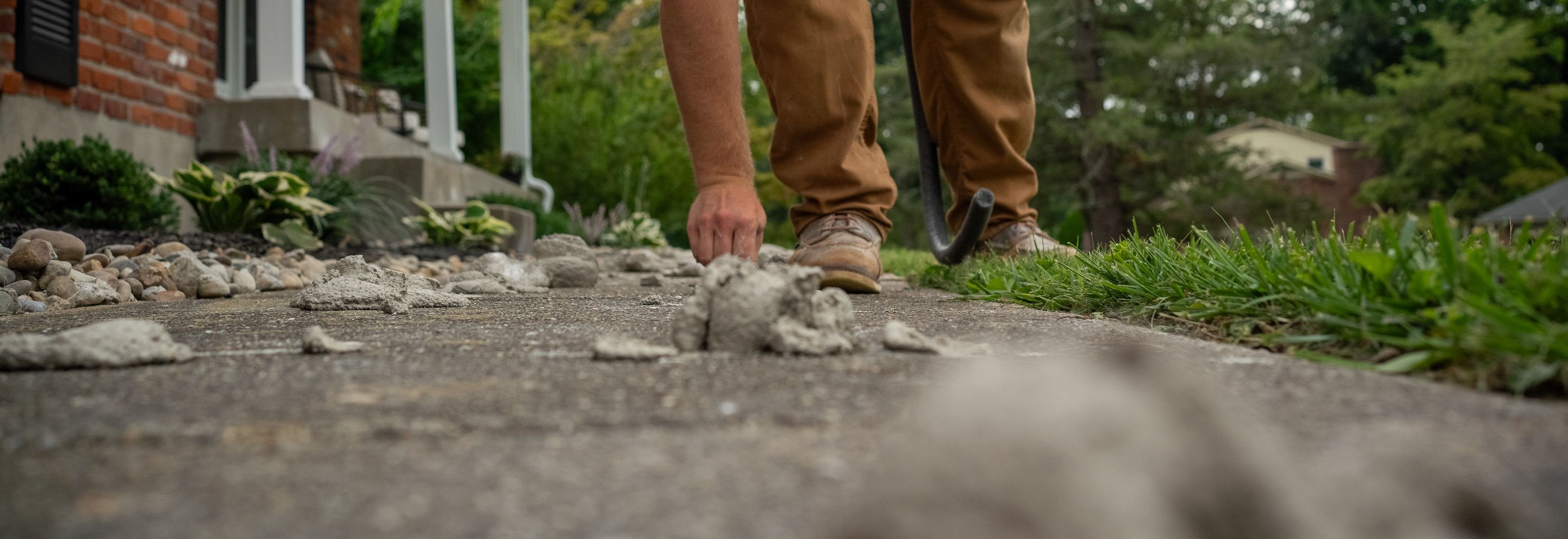
Discover why concrete itself isn’t often used to lift settled slabs.
When it comes to concrete leveling, you might wonder if technicians simply use more concrete to even out what's settled. It's a common misconception, but additional concrete is typically not the material of choice for professional concrete leveling.
Here at A-1 Concrete Leveling, we lift settled concrete using stone slurry grout leveling (and in some locations, foam injection). But the pulverized limestone slurry we use for stone slurry grout leveling often gets mistaken for concrete.
For this reason, we’ve created this article to break down the differences between the two and talk about why we, and most other concrete levelers, don’t use concrete for lifting sunken slabs.
Concrete Leveling 101
Before diving into the specifics, here’s a quick refresher on how concrete leveling works:
- Holes are drilled into settled concrete slabs.
- A material, such as pulverized stone, mud, or foam, is pumped through these holes, filling voids beneath the settled slab and causing it to lift back into position.
- Once the slab is in the right position, the drill holes are sealed off.
Related Resource: How Does Concrete Leveling Work?
What Is Concrete?
Concrete is a widely used building material seen in countless construction applications, from tiny sidewalks to towering skyscrapers. In fact, concrete is the second most consumed material in the world, only after water.
Concrete is composed of sand, gravel, water, and cement. Cement, technically referred to as Portland cement, serves as the binding agent, or the “glue” holding all the aggregates together to make the concrete so strong.
Concrete vs. Cement
Cement and concrete are often mistaken for one another, but cement is actually just one component of concrete.
In order to have finished concrete, you’ll need cement + water + aggregates (sand, gravel). Cement can be added to all kinds of things besides this mixture, and that doesn’t make those things concrete.
What Is “Stone Slurry”?
The pulverized limestone slurry used in the stone slurry grout leveling process looks like concrete visually, and cement can be added to increase its strength, which is why it is often mistaken for concrete.
However, it’s quite different from concrete. It dries to a hard, clay-like state but doesn’t shrink. It can take on water and be broken down or crumbled.
The biggest difference (and benefit!) is that water can still pass easily through the material, but this does not cause it to fall apart. Because just like concrete, it’s strongest when compressed.
Pro Tip: The limestone used in the stone slurry itself is one of the core components used to create Portland cement.
Why Not Use Additional Concrete for Concrete Leveling?
While some contractors do use concrete to perform concrete lifting, it’s more common among concrete repair contractors who don’t specialize in concrete leveling.
Here are the main reasons not to pump more concrete under settled slabs:
Moisture Problems
Concrete is typically designed or engineered to be placed on a strong stone base to support it on the ground and to allow moisture to pass through and away from the concrete.
Pumping additional concrete under the slab inhibits moisture drainage, exposing the concrete to moist underlying soils, which can lead to damage during freeze-thaw cycles.
Bigger Drill Holes
Due to the larger stone gravel within the concrete mixture, bigger holes must be drilled to allow for the material to flow through. These holes usually must be between 2 and 2.5 inches in diameter.
Why Use Stone Slurry for Concrete Leveling?
The stone slurry material, even when mixed with cement for added strength, will allow moisture to pass through it, mimicking the function of a conventional stone base. This helps keep excess moisture away from the concrete slab but also supports it in its new, level position.
But Does It “Cure”?
Many customers want to know how long it takes the stone slurry to “cure” or “set up”, and they are surprised to find out that it may never get completely dry.
The idea of curing comes from new concrete (it takes concrete 24-48 hours for you to be able to walk on it, 7 days for vehicle traffic, and 28 days to reach full curing).
But unlike concrete, the stone slurry material is weight-bearing and strong the moment it’s pumped under the slab, even if completely wet.
It’s not necessary for the stone slurry to get completely dry, or “cure”. In fact, it will likely rehydrate along with the surrounding soils at various times as water passes through it (which is normal and intended by design).
Your Next Steps
By understanding the differences between concrete and stone slurry grout, and why one is better suited for concrete leveling applications, you're better equipped to make informed decisions regarding your uneven concrete.
If you're contemplating concrete leveling for your home or business, explore the resources linked below to dive deeper into your available options:
- The Pros and Cons of Stone Slurry Grout Leveling
- The Pros and Cons of Polyjacking
- The Pros and Cons of Mudjacking
Here at A-1 Concrete Leveling, we offer stone slurry grout leveling in all locations and polyjacking services in some. If you’d like to learn how these services could benefit your concrete, click the link below to request a free onsite cost estimate!
Click Here to Find Your Nearest Location and Receive a FREE Estimate
Sarah Etler joined A-1 Concrete Leveling after receiving her Bachelor of Arts degree in English from Northern Kentucky University. As A-1's Content Marketing Manager, she works closely with industry experts to produce content that will best answer questions related to concrete repair and maintenance practices. Sarah loves living a life full of discovery and is excited every day to see what new things she can learn and share with those around her.